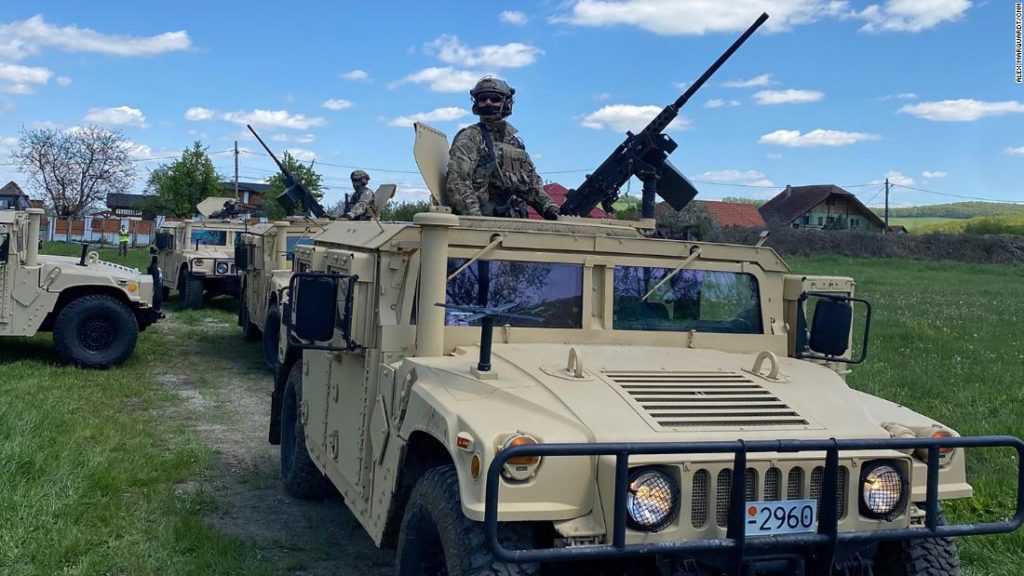Moving past the fallen guards, an American voice – among the mix of men speaking accented English — shouted at two others in a car: “Get out! Hurry up, hurry up.”
The team of US Navy SEALs, along with Romanian and Spanish Special Forces, quickly and quietly worked their way through the warehouse, firing on enemy fighters and, when possible, taking them prisoner.
When the operation was done, the assaulting team — whose ammunition had consisted of plastic projectiles and paint rounds — was told by an instructor they had passed the course and to get back in position to run it again.
Both sets of military training exercises, while long-planned, follow a series of aggressive Russian military moves across Europe.
CNN was given exclusive access to see the American special forces – the SEALs and US Army’s Green Berets – exercise in Romania and North Macedonia over several days. In central Romania, the Green Berets fast roped and rappelled down from helicopters alongside Ukrainian and Romanian soldiers before blasting and shooting their way into a makeshift house.
In North Macedonia, American special air tactics airmen taught local troops how to call in targets for an AC-130 plane that was firing on a distant ridgeline, the Macedonians carefully annunciating the coordinates in halting English.
One salvo, called in by an American officer, was significantly off target, appearing to be the result of a misunderstanding between the ground and air forces: A potentially deadly mistake that spoke to why live fire training is so vital.
The annual exercises were canceled last year during the outbreak of the coronavirus pandemic and while they are over a year in the making, it is lost on no one that they coincide with a dramatic escalation of tension between Russia and the West.
“We have to be strong and supportive of our allies when there is a threat,” said David Muniz, the most senior US diplomat in Romania who serves as the embassy’s chargé d’affaires. “When we are strong, when we are united, it has a real chilling effect, shall we say, on the kinds of things that can happen.”
“In this way, you cut down on the chance for mischief,” he added, shortly before American paratroopers from the 82nd Airborne Division poured out of transport planes over a Romanian airfield in Boboc.
Few diplomatic or military officials — American or otherwise – wanted to speak specifically about the Russian threat though several privately admitted there’s no doubt it is hanging over these exercises.
“It’s just showing everybody that we have a capability and we can use it when necessary,” said Major General Joe Jarrard, the deputy commander of the US Army in Europe and Africa, downplaying the significance of the timing of the exercises. “We’re going to continue to develop our readiness and the interoperability between all of the allies and partners and so that’s what we’re continuing to focus on.”
The head of Romania’s special forces, which copied much from the Americans during the development of their forces, admitted that the Russian maneuvers not far from their coastline in the Black Sea are unsettling.
“They should be of concern for us,” said Lieutenant General Daniel Petrescu. “Our job is to train harder and harder and be prepared for everything.”
“We discussed in some detail the support that we’re providing, we’ll continue to provide to Ukraine to continue to strengthen its security, its defenses,” Blinken said.
“The objective would be to neutralize the Ukrainian naval forces, gain complete sea control in the northern Black Sea, cut off Ukrainian military forces from their supply lines, and obtain dominance over a section of land that could connect Russia with Crimea,” Stavridis wrote.
A Russian attack on Ukraine would not necessarily compel the US and the rest of NATO to intervene, since it is not part of the alliance. NATO did not respond militarily to Russia’s annexation of Crimea but has refused to recognize it as Russian territory.
A big part of the aim of the NATO exercises now, beyond sending a message to Russia and others, is simply at a tactical level: should the allies and partners need to join a fight together, they know how to work alongside each other and cross-pollinate with other countries’ equipment.
“It’s just to build that knowledge with each other,” said a Green Beret operator who CNN wasn’t allowed to identify. “It shows that we’re willing to learn from each other. It is important, significant, whatever’s going on around the world.”
You may also like
-
Afghanistan: Civilian casualties hit record high amid US withdrawal, UN says
-
How Taiwan is trying to defend against a cyber ‘World War III’
-
Pandemic travel news this week: Quarantine escapes and airplane disguises
-
Why would anyone trust Brexit Britain again?
-
Black fungus: A second crisis is killing survivors of India’s worst Covid wave

